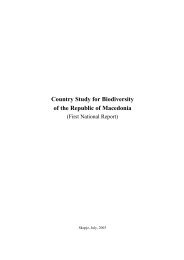CBD Fourth National Report - Azerbaijan (English version)
CBD Fourth National Report - Azerbaijan (English version)
CBD Fourth National Report - Azerbaijan (English version)
You also want an ePaper? Increase the reach of your titles
YUMPU automatically turns print PDFs into web optimized ePapers that Google loves.
Country Study on Biodiversity and <strong>Fourth</strong> <strong>National</strong> <strong>Report</strong><br />
The Republic of <strong>Azerbaijan</strong><br />
protection of marine (Caspian) bioresources; (v) forest management; and (vi) protected<br />
areas. Further information about the work of the Ministry can be found on their website<br />
(www.eco.gov.az).<br />
• The Ministry of Agriculture. As a major land user and the biggest user of water<br />
resources in the country (using 75% of supplies) agriculture has a significant impact on<br />
biodiversity. The Ministry of Agriculture carries out work on plant protection and on the<br />
rural environment. It runs a number of research institutes, focusing on crop and vegetable<br />
cultivation, horticulture, cultivation of cotton, grapes and fodder and livestock breeding,<br />
In addition, the Ministry of Health, the Ministry of Youth, Sport and Tourism, and the State<br />
Committee of Land and Cartography conduct some activities which are relevant to<br />
biodiversity conservation. Other relevant state organizations include:<br />
• State Commission of Genetic Resources on Biodiversity. This was established by<br />
Presidential Decree in December 2002, to implement measures in line with <strong>Azerbaijan</strong>’s<br />
commitments under the Convention on Biological Diversity in order to prevent the loss of<br />
genetic resources of plants, animals and microorganisms.<br />
• <strong>National</strong> Academy of Sciences. This is key national scientific research organization, and<br />
operates a series of research institutes, many of which conduct work relevant to<br />
biodiversity conservation (including, among others, the Institutes of Geography, Botany,<br />
Zoology, Genetic Resources, Microbiology, Oil-Chemistry Processes and Soil Research).<br />
Further information about the work of the ANAS can be found on their website<br />
(www.science.az).<br />
4.3.2. Non-governmental organisations<br />
At present there are over 60 ecological NGOs and associations, of which up to 30 are on<br />
biodiversity (See Annex 9.2). Among these are scientific groups undertaking basic<br />
biodiversity research (such as the Society of Botanists, the Society of Zoologists, the Society<br />
of Geographers, the Society of Mammologists and the <strong>Azerbaijan</strong> Centre for the Protection of<br />
Birds). A number of other NGOs are active in environmental education relating to<br />
biodiversity, and have an important role in raising public awareness.<br />
4.3.3. Business and the private sector<br />
In addition to local private entrepreneurs a number of international corporations operate in the<br />
Republic of <strong>Azerbaijan</strong>. Representatives of local private businesses have not yet taken an<br />
active role in solving environmental problems, mainly due to the relatively early stage of<br />
business development in <strong>Azerbaijan</strong>. In general, foreign investors have been more involved in<br />
ecological protection that the local business sector. In particular, the oil sector (including<br />
companies such as BP, Exxon Mobil) has been directly involved in biodiversity protection<br />
activities, as a result of their recognition of both potential corporate impacts and social<br />
responsibility.<br />
Of particular note is the work undertaken to date by BP, whose local operation (BP<br />
<strong>Azerbaijan</strong>) has developed the Biodiversity Strategy, in full consultation with local<br />
stakeholders. Under this strategy BP will support both short-term local projects (to be<br />
delivered by local NGOs under a small grants scheme) and longer-term regional initiatives<br />
109<br />
2009

















